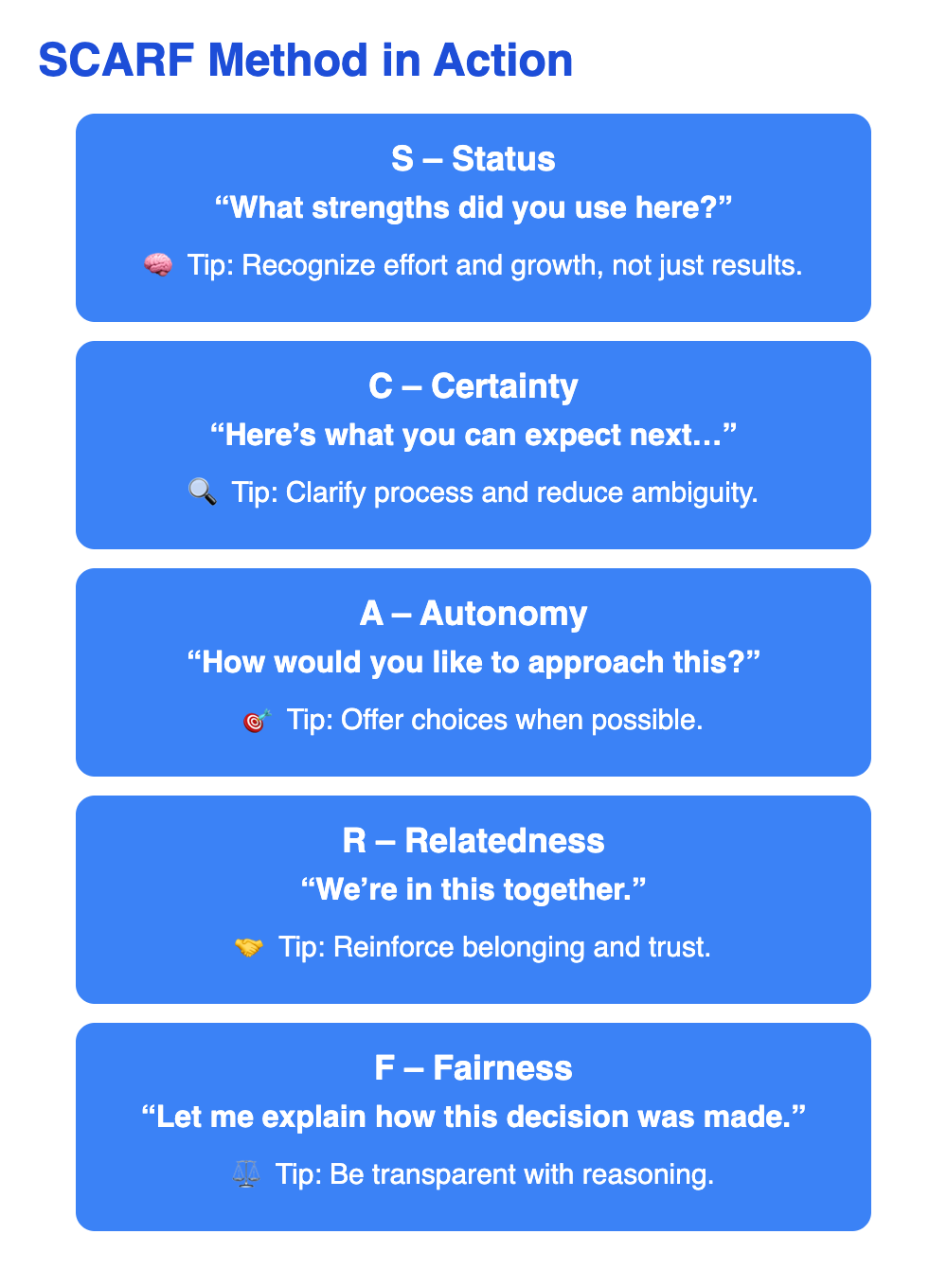Welcome to the course on "Aligning Team Motivation with Sales Targets and Compensation Plans." As a sales manager, your role transcends mere target-setting; it's about inspiring your team, aligning their motivations with company goals, and creating a culture of enthusiasm and accountability. Throughout this course, you will engage in realistic role-play scenarios to practice key strategies, such as effectively communicating sales goals, connecting them with compensation plans, and guiding your team through challenges and changes. These skills are vital for driving team performance.
Let's dive in and explore how you can become a transformational leader when presenting new sales targets and changes to the team.
Presenting new sales targets can be daunting, but the way you communicate these changes significantly impacts how your team perceives them. By applying the SCARF model—developed by David Rock and based on neuroscience—you can ensure that your message reduces resistance and fosters engagement.
- Status: Recognize the team’s previous achievements,
"First, I want to congratulate everyone on a great quarter." - Certainty: Provide clarity on what the change means,
"We’ve set new sales targets for the next quarter. Let me walk you through the numbers." - Autonomy: Involve the team in the change process,
"Before we finalize individual goals, I want to hear your thoughts on these targets and your planned approach." - Relatedness: Foster a shared team purpose to maintain connection and trust,
"The stronger we perform as a team, the more opportunities we’ll have to grow." - Fairness: Communicate the rationale behind decisions,
"I want to be completely transparent about how these targets were set."
The SCARF model empowers sales leaders to manage change and present new sales targets in a way that minimizes resistance, increases engagement, and reinforces team alignment with company goals, enhancing buy-in and performance.

The Autonomy aspect of SCARF emphasizes the importance of involving your team in the change process. As a sales leader, seek team input on new sales targets to develop more effective strategies and build ownership. People respond better to change when they feel they have some control over how they implement it.
For example, you can allow salespeople to have input on how they’ll meet the targets or encourage creative solutions and empower them to test new approaches.
Here's a sample dialogue illustrating this approach:
- Chris: "As we approach the new targets, I want to gather your thoughts on how we can achieve them effectively. What strategies do you think will work best for your region?"
- Nova: "I've been considering a mix of more personalized client outreach and leveraging social media platforms to reach potential customers. It might help us engage better with a younger demographic."
- Chris: "I like the sound of that. How do you envision implementing these strategies? Do you need any specific resources or support to get started?"
- Nova "If we could have access to the social media team and marketing support on crafting effective outreach messages, that would be a great start."
- Chris: "Let's make that happen. Feel free to experiment with these new approaches, and keep us updated on the results. We'll review their impact and adjust as needed."
By encouraging input and fostering innovative strategies, you empower your team to take ownership of their targets and collaborate towards achieving them.
The Relatedness and Fairness elements of SCARF can be leveraged to maintain team connect and trust while communicating the rationale behind changes.
Focusing on Relatedness and shared purpose helps your team be more likely to embrace change because they feel connected to others and trust their leaders. Frame the new targets as a team effort. You can say something like, “We’re in this together. Hitting these targets means we’ll all succeed and contribute to the company’s growth.”
You can also share stories or examples of how other teams have successfully handled similar challenges. Remember to offer regular check-ins and keep communication open to maintain a sense of trust and connectedness.
Salespeople are highly sensitive to perceived Fairness, especially regarding quotas and compensation. Your role is to ensure transparency by communicating the rationale behind changes. Explain how the sales targets were determined. For example, “We reviewed past performance, market potential, and individual territories to set fair and achievable targets.”
Be transparent about the metrics that will be used to evaluate performance and ensure that everyone is measured on the same criteria. Offer equal access to resources (e.g., training, leads, tools) and explain how the compensation structure aligns with the new targets. Provide an open forum for feedback on perceived fairness, and be willing to make adjustments where necessary.
As you wrap up these foundational concepts, prepare to put them into practice in the upcoming role-play sessions. These scenarios are designed to refine your skills in inspiring, involving, and innovating with your team for successful target attainment. Before you dive into the role-plays, let's first review the SecureCore case study which will be used throughout this course.
